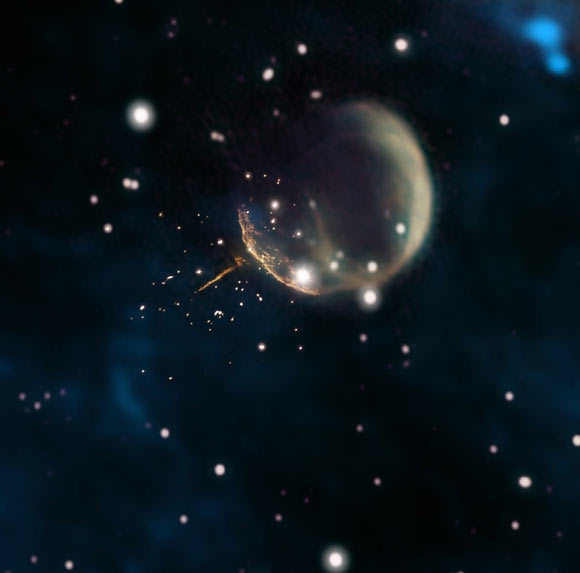Astronomers using NASA’s Fermi Gamma-ray Space Telescope and NSF’s Karl G. Jansky Very Large Array have spotted a pulsar hurtling through space at nearly 700 miles per second (1,127 km/sec). Named PSR J0002+6216, the pulsar sports a radio-emitting tail pointing directly toward the expanding debris of a recent supernova explosion, CTB 1.

The CTB 1 supernova remnant resembles a ghostly bubble in this image, which combines new 1.5 GHz observations from the Very Large Array (orange, near center) with older observations from the Dominion Radio Astrophysical Observatory’s Canadian Galactic Plane Survey (1.42 GHz, magenta and yellow; 408 GHz, green) along with infrared data (blue). The VLA data clearly reveal the straight, glowing trail from PSR J0002+6216 and the curved rim of the remnant’s shell. Image credit: Jayanne English, University of Manitoba / NRAO / F. Schinzel et al / DRAO / Canadian Galactic Plane Survey / NASA / IRAS.
Pulsars are superdense, rapidly spinning neutron stars left behind when a massive star explodes. Their rotational periods ranging from more than 10 seconds to just a few milliseconds. Since their discovery in 1967, various surveys have discovered over 2,600 pulsars.
PSR J0002+6216 was discovered in 2017 by a citizen-science project called Einstein@Home.
Located about 6,500 light-years away in the constellation Cassiopeia, this pulsar spins 8.7 times a second, producing a pulse of gamma rays with each rotation.
“This pulsar has completely escaped the remnant of debris from the supernova explosion. It’s very rare for a pulsar to get enough of a kick for us to see this,” said Dr. Frank Schinzel, an astronomer at the National Radio Astronomy Observatory (NRAO).
Radio observations with the Very Large Array clearly show PSR J0002+6216 outside the supernova remnant, with a tail of shocked particles and magnetic energy 13 light-years long behind it. The tail points back toward the center of the CTB 1 supernova remnant.
“Measuring the pulsar’s motion and tracing it backwards shows that it was born at the center of the remnant, where the supernova explosion occurred. The pulsar now is 53 light-years from the center of CTB 1,” said Dr. Matthew Kerr, of the Naval Research Laboratory.
“The explosion debris in the supernova remnant originally expanded faster than the pulsar’s motion,” said Dr. Dale Frail, of NRAO.
“However, the debris was slowed by its encounter with the tenuous material in interstellar space, so the pulsar was able to catch up and overtake it.”
PSR J0002+6216 apparently caught up with the shell about 5,000 years after the explosion. The system now is seen about 10,000 years after the explosion.
The pulsar is speeding through space 5 times faster than the average pulsar, and faster than 99% of those with measured speeds. It will eventually escape our Milky Way Galaxy.
Exactly how the pulsar was accelerated to such high speed during the supernova explosion remains unclear, and further study of PSR J0002+6216 will help shed light on the process.
One possible mechanism involves instabilities in the collapsing star forming a region of dense, slow-moving matter that survives long enough to serve as a ‘gravitational tugboat,’ accelerating the nascent neutron star toward it.
“Numerous mechanisms for producing the kick have been proposed. What we see in PSR J0002+6216 supports the idea that hydrodynamic instabilities in the supernova explosion are responsible for the high velocity of this pulsar,” Dr. Frail said.
“We have more work to do to fully understand what’s going on with this pulsar, and it’s providing an excellent opportunity to improve our knowledge of supernova explosions and pulsars,” Dr. Schinzel said.







